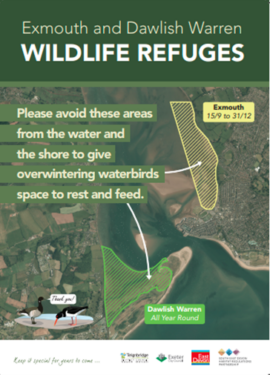The Exe Estuary is one of the most highly designated sites in the Southwest and is protected for its globally important wildlife and habitats. The estuary is a feeding and breeding ground for thousands of birds, supporting internationally important populations such as Redshank, with Exminster one of only two places in Devon where they breed.
Since 2018, two wildlife refuges have protected water birds on the Exe Estuary. The Exmouth Local Nature Reserve wildlife refuge operates from 15 September to 31 December every year. The Dawlish Warren National Nature Reserve wildlife refuge operates all year round.

The Exmouth Wildlife Refuge protects a large eelgrass (Zostera spp.) bed on mudflats within Exmouth Local Nature Reserve, stretching from the Duck Pond, up towards Lympstone. Eelgrass is the main food plant for over-wintering species such as Dark-bellied Brent Geese and Wigeon and is the most nutritionally dense food these species can consume.
The Dawlish Warren Wildlife Refuge protects an area of saltmarsh, inter-tidal mudflats, and the most important high-tide roost on the lower estuary. At low tide, when the mudflats are exposed, the Refuge provides rich feeding grounds for waders and wildfowl, including Curlew, Redshank, Bar-tailed Godwit and Greenshank. At high tide, Oystercatcher, Dunlin, and Grey Plover, find shelter on ‘hide island’ and ‘finger point’.
To ensure that birds can rest and feed in this area undisturbed, we ask that everyone avoid entering the Dawlish Warren Refuge all year round, at all tidal states.
Birds rely on a safe space to rest at high tide when their food source is unavailable. The closer this is to their source of food, the better for conserving energy, especially during the cold winter months.
Migratory birds need to rest and refuel when they arrive at their wintering grounds, they spend their time here building up energy-reserves for migration and to ensure they are at their fittest for the breeding season. If they are not well rested and fed, they may not have the energy to breed successfully, leading to population decline.
Some human activities can disturb birds from their natural behaviour. Sadly, we often cause bird disturbance without even realising.
It’s difficult to advise a safe distance to observe shore birds – the proximity at which disturbance occurs depends on a number of factors – whether there is a history of disturbance at that site, on flock size and species, acclimatisation and weather conditions all contribute to how tolerant flocks are.
Before birds take flight, signs they are stressed about your proximity can include:
- they will stop feeding, or become alert if previously resting, and all look in the direction of the preserved threat.
- alarm calls from individuals or an increase in volume across the flock.
- swim or if on the shore, move away.
- once distance between you and them becomes too little they will take flight as a last resort.
When birds are disturbed, they stop feeding or resting and may even fly away. Over time, with repeated disturbance, the energy lost can affect their fitness and survival.
We welcome you to visit the Exe Estuary and please consider your impact on the wildlife you are hoping to observe. Birds are especially sensitive to disturbance and repeated disturbance can threaten their survival.
For these reasons, collecting disturbance reports from the public and local groups is so important, and can help us support the monitoring of the refuges. The data we collect through our new wildlife disturbance form will be stored within the Exe Estuary Management Partnership database but will be shared with our partners and the South East Devon Habitat Regulations Partnership (SEDHRP) to support the ongoing management of the designated sites.
If you have witnessed a disturbance incident, you can now fill out our wildlife disturbance form. It is important that public reports of disturbance are as detailed as possible (as per the attached form) because verbal (or emailed) reports that don’t contain this detail can be dismissed under scrutiny as largely anecdotal and therefore, unverifiable.
This form has been developed as a partnership between the Exe Estuary Management Partnership, South East Devon Habitat Regulations Partnership, Natural England, RSPB, and Footprint Ecology, which maintains consistency with the established monitoring of the refuges. This includes recording instances whereby people enter the refuge(s) but there is no observable disturbance (recorded as either ‘No Response’ or ‘Alert’). The form also contains guidance notes and local maps.
We would appreciate you completing as much of the form as possible, but there is no expectation to fill out all sections if you do not have the information to do so.
You can also see our leaflet on wildlife in the Exe Estuary and codes of conduct for more information.
Reporting suspicious fishing activities | Devon and Severn IFCA
For urgent reports, contact 07740175479
For less urgent reports, email intel@devonandsevernifca.gov.uk